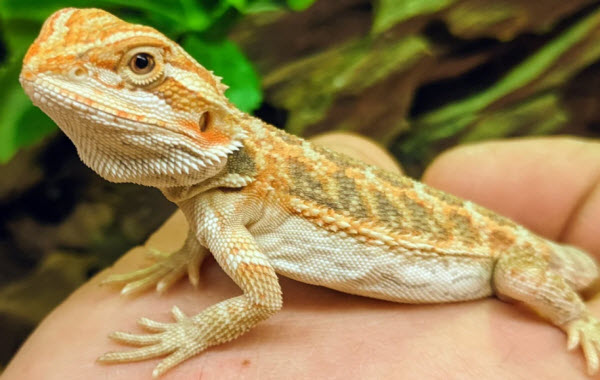In the quest to understand gender preference and its impact on life, one can look to the animal kingdom, which offers compelling examples of how gender identity can be fluid and adapt to environmental pressures. Many animals possess the remarkable ability to change their reproductive identity through sexual transformations from male to female or vice versa, or even to adopt behaviors typical of the opposite sex to achieve specific goals during certain life stages. This exploration into the biological diversity of the animal kingdom reveals a wealth of astonishing adaptations that challenge our traditional views on gender and survival.
Bearded Dragon (Pogona vitticeps): In a process known as “sex reversal,” bearded dragons have demonstrated the ability to transform from male to female to some extent while still within the egg. Researchers have observed that these reptiles retain their male genetic traits but exhibit female reproductive roles, including laying more eggs than female counterparts. This phenomenon appears to occur naturally and might be influenced by climatic changes due to global warming. Previous lab studies have shown that exposing these dragons to high temperatures can induce genetic sex changes from male to female. Understanding this sexual flexibility may provide insights into how the animal kingdom responds to climate change, helping predict the effects of environmental shifts on global biodiversity.

Clownfish (Amphiprioninae): All clownfish are born as males. To ensure the continuation of their species, some dominant and larger males undergo a sex change to become females in a process known as sequential hermaphroditism. After this transformation, other males gather to fertilize the eggs. If the female dies, the next dominant male in line will transform into a female, ensuring the species’ survival.

Wrasses (Labridae): In wrasse fish, when the dominant male dies or leaves temporarily, the largest female quickly undergoes a sex change to become the new dominant male. This transformation, which involves the development of male reproductive organs within two weeks, results in increased aggression to secure the group and ensure reproductive success. This process contrasts with clownfish, where males transform into females rather than the reverse.

Banana Slug (Ariolimax dolichophallus): The vibrant yellow banana slug, reaching lengths of 15 to 20 centimeters, is one of the largest slug species. These slugs are hermaphroditic, possessing both male and female reproductive organs. During mating, banana slugs seek partners of similar size, engage in copulation, and then bite each other’s genitalia—a behavior whose purpose remains debated. Some researchers speculate it might be related to the entanglement of genitalia or sperm competition, while others suggest it may involve self-fertilization in rare cases.

Whiptail Lizard (Cnemidophorus spp.): Whiptail lizards, found abundantly in New Mexico, are all females. Despite this, they maintain their species through a unique method involving genetic modification and sexual transformation. These lizards have evolved to possess double the number of chromosomes compared to their male counterparts, allowing them to reproduce asexually while preserving genetic diversity within their population.

Cuttlefish (Sepiidae): Some male cuttlefish have developed a peculiar strategy to attract females by changing their appearance to resemble females. Researchers found that by altering one side of their body to appear female, cuttlefish males can avoid conflicts with other males and gain more time to court females before other males intervene.

Parrotfish (Scaridae): While parrotfish are typically born as females, they possess both male and female reproductive organs, making them primary hermaphrodites. This means that females can transition to males at any stage of their lives. The reasons behind this sex change remain unclear, though it may help balance the sex ratio within the group. Post-transition, some males exhibit larger sizes and vibrant colors compared to typical parrotfish males.

Garter Snake (Thamnophis spp.): Garter snakes exhibit unusual mating behavior by forming large balls during mating season. When emerging from hibernation, males might mimic females to avoid confrontation with other males. This sexual mimicry serves two evolutionary purposes: providing camouflage against predators and enabling “female” mimics to warm up more rapidly, thus becoming more active compared to their counterparts.

Blackfin Goby (Gobiodon spp.): Certain species of blackfin gobies can undergo sexual transformations based on need, typically changing from female to male when the dominant male dies. However, in some cases, young gobies can transform in the opposite direction. This process, which takes about two weeks due to the similarity in external sexual organs, also involves behavioral changes. Females transitioning to males may adopt more aggressive behaviors, with some species having the ability to revert to their original sex.

Frog (Anura): Research has shown that the herbicide atrazine can induce sex changes in frogs, causing what is termed “chemical castration.” Studies have found that up to 10% of male frogs exposed to atrazine have become female. While these frogs can still mate successfully with other males, their offspring will predominantly be male, potentially leading to significant imbalances in sex ratios and even extinction in some species.

These examples illustrate the incredible flexibility and diversity in reproductive strategies within the animal kingdom, providing a profound understanding of how gender can adapt in response to environmental and evolutionary pressures.
